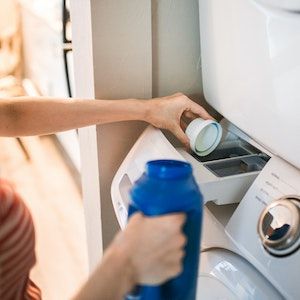Laundry detergents—specifically their sodium dodecyl sulfate (SDS) component—impact the epidermal barrier of both living human skin and ex vivo skin, according to recent findings, and consistent exposure to detergents could disrupt the skin's protective barrier and affect the emergence of atopic conditions.1
These findings were observed in a new study conducted following a rising tide of research showing an epidemiological link between domestic and professional cleaning agents such as detergents, with studies often highlighting increases in prevalence of rhinitis, asthma, and allergic contact dermatitis.2
Summary of Research
- Led by Arturo O. Rinaldi from the Swiss Institute of Allergy and Asthma
- Research reveals that sodium dodecyl sulfate (SDS) in laundry detergents can potentially contributing to the development of atopic conditions.
- Conducted on mice and ex vivo human skin, demonstrates exposure to common household laundry detergents reduces skin barrier integrity, with a marked decrease in electric impedance and increased transepidermal water loss.
- Indicated that changes in gene expression and protein levels related to skin barrier function.
- Highlighted the need for further investigation into the long-term effects of detergents on the skin, especially in those with skin disturbances.
This new research into the components of detergent and their effects on the skin’s barrier was led by Arturo O. Rinaldi, from the Swiss Institute of Allergy and Asthma Research (SIAF) at University of Zürich in Davos, Switzerland.
“The present study aims to evaluate the in vivo effects of household laundry detergents on skin barrier integrity, even used at low concentration,” Rinaldi and colleagues wrote. “We treated mouse skin with different dilutions of two household laundry detergents…”
Background and Findings
The study’s investigators bought C57BL/6 mice from Charles River in Germany, keeping them in a specific-pathogen-free area within the AO Research Institute in Davos. The team utilized these mice for experiments when they were 8 - 12 weeks of age.
After removing the hair from their back skin with an epilation cream, the investigators gave the mice an incubation period of 3 days and, subsequently, the mice were subjected to the application of 2 common household laundry detergents, denoted as detergents A and B.
These 2 detergents were applied by the research team with a skin patch and were administered at varying dilutions (1:100, 1:1000, and 1:10,000 with phosphate-buffered saline [PBS]) for a total duration of 4 hours. In the initial experiments, the team assessed various time intervals, ultimately deciding that the most suitable time frame for the investigation was 4 hours.
As a control and for the purpose of dilution, PBS was used in the investigators’ research. After the specified time intervals, the mice in the experiment were humanely euthanized, and samples of the treated skin were meticulously gathered. Ex vivo human skin samples were acquired by the team through purchase.
Human skin samples were obtained from individuals who had undergone abdominoplasty procedures and had provided written informed consent, and the investigators noted that the donors had no history of dermatological conditions, allergies, or corticosteroids.
The adult skin explants used by the research team originated from 2 female donors—aged 32, 37, and 57 years—all of whom were shown to be in good health. Each sample consisted of naturally obtained 15mm diameter circular skin biopsies, and these were encased by the team in custom-built plastic inserts.
Following their 4-hour exposure process with the detergents, the investigators evaluated the skin's barrier function through electric impedance spectroscopy (EIS) and measurements of transepidermal water loss (TEWL). The research team’s skin biopsy samples were given both RNA sequencing (RNA-seq) and targeted multiplex proteomics analyses. Furthermore, they noted that the impact of a 6-hour treatment with detergent and SDS on ex vivo human skin was examined.
The team noted in their conclusions that the detergent exposure led to a distinct reduction in EIS as well as an increase in TEWL versus untreated skin. In fact, EIS was shown to have a more heightened sensitivity to the treatment and it indicated a clear dose-response relationship.
The investigators’ RNA-seq analysis’s results indicated a reduction in the expression of several different genes known to be necessary for the skin's barrier integrity, including ones known to be responsible for tight junctions and adherens junction proteins. In contrast, the team reported an upregulation in the genes linked to lipid metabolic processes, keratinization, and differentiation of epidermal cells.
The research team’s proteomics analysis led to the conclusion that there was a general downregulation of proteins linked to cell adhesion, such as epithelial cell adhesion molecule and contactin-1. Meanwhile, proinflammatory proteins such as interleukin-1 beta and interleukin-6 were upregulated.
The investigators noted the importance of acknowledging that both SDS and detergents resulted in a major decrease in EIS values in the ex vivo human skin model.
“Overall, our data indicate that laundry detergents can impact the epidermis integrity and suggest further research to evaluate the long-term effect of detergents on the skin barrier, particularly in patients with skin disturbances,” they wrote.
References
- Rinaldi, AO, Li, M, Barletta, E, et al. Household laundry detergents disrupt barrier integrity and induce inflammation in mouse and human skin. Allergy. 2023; 00: 1-13. doi:10.1111/all.15891.
- Folletti I, Siracusa A, Paolocci G. Update on asthma and cleaning agents. Curr Opin Allergy Clin Immunol. 2017; 17(2): 90-95.





